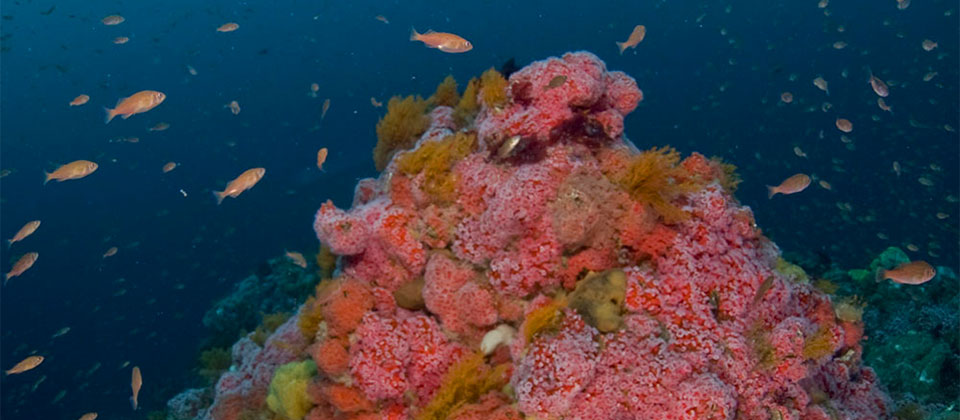Media

Cordell Bank National Marine Sanctuary is managed with Greater Farallones National Marine Sanctuary. Visit the news page for media and information about Cordell Bank National Marine Sanctuary.
History of CBNMS
In July 1981, the National Oceanic and Atmospheric Administration (NOAA) received a recommendation to establish Cordell Bank as a national marine sanctuary from Cordell Expeditions, a non-profit organization dedicated to the exploration and description of the Bank. NOAA evaluated the recommendation in accordance with the requirements of the National Marine Sanctuary Program regulations (15 CFR 922). Cordell Bank was found eligible for inclusion on the List of Recommended Areas and was placed on the list in 1981. More complete information on the site was collected by NOAA and incorporated into a resource summary and site description that was distributed to the public and agencies for comment in 1982. It was determined that Cordell Bank was an area of special significance that was not adequately protected. The final rule went into place in 1989, and Cordell Bank was designated a national marine sanctuary.In 2015, NOAA expanded Cordell Bank National Marine Sanctuary north and west to include additonal nationally-significant features, including Bodega Canyon, marine and historical resouces, submerged lands, and nutrient-rich upwelled waters. NOAA made this decision after review of public input and agency gathered from December 2012-June 2014, and additional subsequent agency input. The final rule became effective June 9, 2015. As of 2021, there is one superintendent who manages Cordell Bank National Marine Sanctuary and Greater Farallones National Marine Sanctuaries together.
Cordell Bank National Marine Sanctuary has been vested with the authority, in accordance with the National Marine Sanctuaries Act (NMSA), to provide comprehensive and coordinated conservation and management of sanctuary and the activities affecting the sanctuary. The sanctuary location is from about 6 to 44 nautical miles west of Bodega Head and south about 34 nautical miles. Cordell Bank itself is about 45 nautical miles northwest of San Francisco. The sanctuary shares its northern and eastern boundaries with a portion of the Greater Farallones National Marine Sanctuary's boundaries. Cordell Bank National Marine Sanctuary encompasses an area of approximately 971 square nautical miles.
Cordell Bank
Cordell Bank is characterized by a combination of oceanic conditions and undersea topography that supports rich and diverse marine communities. Two worlds come together at this offshore-submerged island: open ocean species thrive in close proximity to a benthic reef community.The bank consists of a series of steep-sided ridges and narrow pinnacles resting on a plateau 300 to 400 feet deep. The shallowest depth on Cordell Bank is 115 feet below the sea surface, yet only a few miles to the west there are water depths of 6,000 feet.
The calendar year at Cordell Bank can be broken into three oceanographic seasons: upwelling season, relaxation season, and winter storm season.
Seabirds and Marine Mammals
The waters around Cordell Bank provide critical foraging habitat for many species of seabirds. Seabird density over Cordell Bank can be among the highest of any area in central and northern California. Nearly seventy bird species have been observed in the sanctuary. The composition of seabirds found at Cordell Bank is a mix of local breeding birds and highly migratory, open-ocean species.
Management
The highest priority for CBNMS is resource protection. The sanctuary staff takes a leading role in ecosystem management, focusing on biological and physical processes. Together, with our partners, we work to protect biological communities and their habitats. By addressing current management issues and anticipating future challenges to Cordell Bank National Marine Sanctuary, we strive to maintain a healthy marine environment now and for future generations.The sanctuary staff seeks to:
- Improve the conservation, understanding, management, and sustainable use of marine resources
- Enhance public awareness, understanding, and appreciation of the marine environment
- Investigate and enhance understanding of ecosystem processes through continued scientific research, monitoring, and characterization to support ecosystem-based management
- Maintain for future generations the habitat and ecological integrity of the natural assemblage of living resources that inhabit these areas
- Maintain the natural biological communities, protecting and (where appropriate) restoring natural habitats, populations, and ecological processes
- Provide authority for comprehensive and coordinated conservation and management of these marine areas and activities affecting them, in a manner that complements existing regulatory authorities
- Create models of, and incentives for, ways to conserve and manage these areas, including the application of innovative management techniques
- Cooperate with global programs encouraging conservation of marine resources.

